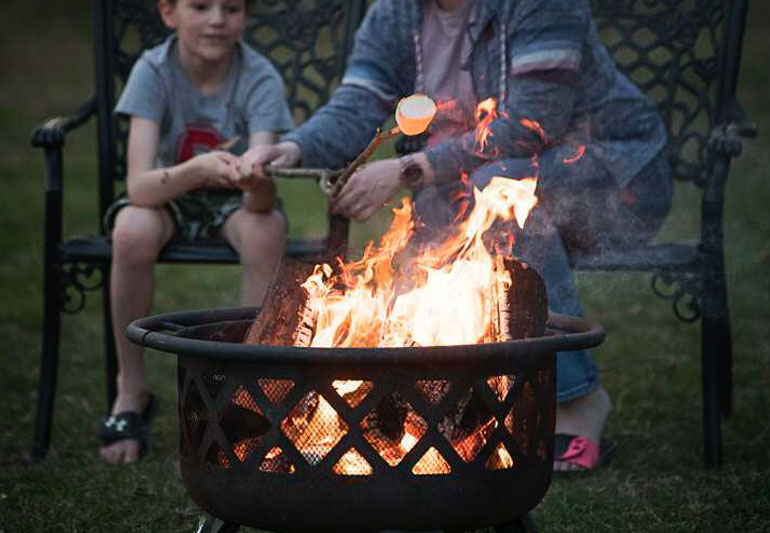

Planning to gather friends or family around a crackling bonfire or cozy fire pit? Absorb the atmosphere — not the smoke.
Wood smoke contains millions of tiny particles. When you breathe in smoke, the particles can get deep into your respiratory system.
You’ve likely experienced the results before — stinging eyes, runny nose and coughing. These symptoms are short-lived for most people. But for those with underlying respiratory illnesses, inhaling smoke is dangerous.
Here’s how to protect your lungs and make your next fire safer, according to pulmonologist Bohdan Pichurko, MD.
Fires and your health
Most people can enjoy an outdoor fire safely by not sitting too close and not breathing in the smoke. But it’s a different story for the nearly 40 million Americans with asthma or chronic obstructive pulmonary disease (COPD), including emphysema, says Dr. Pichurko.
“If you have an underlying respiratory disease, inhaling smoke from wood, even briefly, can cause a chain of airway tightening that can land you in the emergency room. If you have asthma or COPD, take extra precautions,” he advises. “Sit as far from the fire as possible, and pay attention to which way the wind is blowing at all times.”
Your lungs can’t take the heat
Smoke isn’t the only health hazard you should avoid. The heat itself is harmful. “Inhaling air that is consistently at a higher temperature than the surrounding air can cause more damage to the lining of your lower respiratory tract than smoke inhalation,” says Dr. Pichurko.
If you feel intense heat on your hands or face, that’s a clear signal that the air you’re breathing is too hot and you should move back from the fire.
Fire building safety tips
If you’re like most people, you may not give much thought to constructing your fires. But Dr. Pichurko says you should. Here are his seven best tips for building safer fires outdoors:
- Use only untreated wood. It’s best to use wood that has been well-seasoned (for six months to a year) and kept dry. This can reduce the amount of smoke your fire produces. Pressure-treated lumber, railroad ties and wood from construction sites can contain toxic chemicals such as arsenic and aren’t safe to burn.
- Play it safe with manufactured logs. Manufactured logs are typically made of sawdust and wax or similar materials. They may produce less smoke than traditional firewood, but that doesn’t make the smoke any safer, Dr. Pichurko says. They can contain many ingredients and it’s impossible to predict how your lungs will react. Also, if you plan to cook anything over a fire of manufactured logs, find a brand approved for cooking (since most aren’t).
- Choose a calm day. If winds are blowing at more than 20 miles per hour, it’s probably a good idea to build your fire another day.
- Keep both fire and logs small. Smaller fires burn hotter, more completely and with less smoke. For best results, choose firewood that’s less than 6 inches in diameter.
- Instruct children on fire safety. Children need adult guidance and close supervision around fires. Teach them to keep their distance from fires and limit their exposure to wood smoke. Their respiratory systems are still developing, says Dr. Pichurko.
- Don’t use gasoline or other accelerants to start your fire. Accelerants, such as gasoline, can cause fires to flare up or rage out of control quickly. They can also release toxins into the air. Opt for small sticks or cubes approved for starting fires more safely.
- Keep a bucket of water or a hose nearby. Having a source of water near your fire will ensure that you are ready to act if the flames spread or get out of control. It’s a good idea to keep the potential for respiratory damage in mind and to protect yourself accordingly.
So, don’t say goodbye to toasted marshmallows or cozy nights. Follow the tips outlined above, and you’re on your way to enjoying outdoor fires safely.
more recommended stories
 High-Intensity Training and Oxidative Stress Insights
High-Intensity Training and Oxidative Stress InsightsNew Evidence Linking High-Intensity Training and.
 Perinatal Mental Health Challenges Highlighted in New Study
Perinatal Mental Health Challenges Highlighted in New StudyMental Health Challenges in New Parents:.
 World Summit Outlines Core Principles for Healthy Longevity
World Summit Outlines Core Principles for Healthy LongevityWhy Healthy Longevity Demands a New.
 Cholesterol-Lowering Drugs May Help Reduce PFAS Levels
Cholesterol-Lowering Drugs May Help Reduce PFAS LevelsPer- and polyfluoroalkyl substances (PFAS) continue.
 AI ECG Model Outperforms Standard STEMI Triage
AI ECG Model Outperforms Standard STEMI TriageNovel AI ECG Model Outperforms Standard.
 WHO and EU Strengthen Digital Health in Africa
WHO and EU Strengthen Digital Health in AfricaThe World Health Organization (WHO) and.
 Quitting Smoking Slows Memory Decline, Study Finds
Quitting Smoking Slows Memory Decline, Study FindsQuitting smoking is linked to slower.
 Breakfast Skipping Linked to Metabolic Syndrome
Breakfast Skipping Linked to Metabolic SyndromeBreakfast Skippers May Face Metabolic Consequences.
 Cancer Cells Learn to Self-Report: A New Frontier in Immunotherapy
Cancer Cells Learn to Self-Report: A New Frontier in ImmunotherapyHow a Drug Complex Enables Immune.
 Machine Learning Predicts Early Mortality in IBD Patients
Machine Learning Predicts Early Mortality in IBD PatientsA groundbreaking study published in the.

Leave a Comment